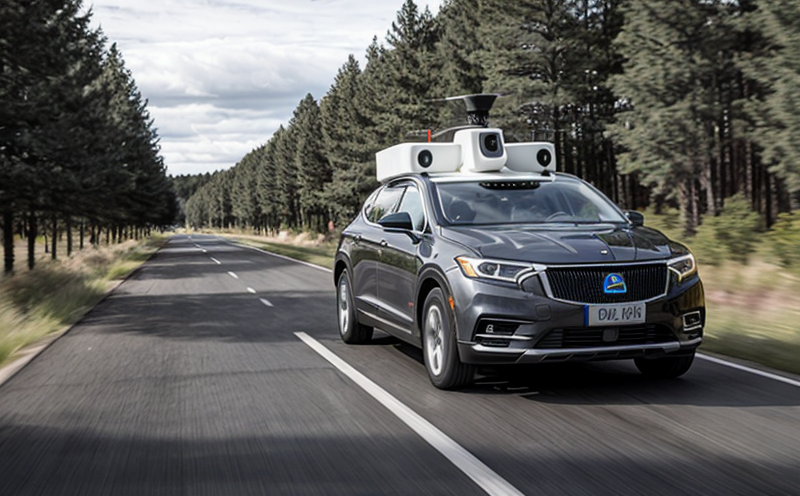ISO 34507 Obstacle Detection and Avoidance in Robot Navigation
The ISO 34507 standard provides a framework for testing autonomous navigation systems to ensure that they can accurately detect, interpret, and avoid obstacles. This service is crucial for robotics and artificial intelligence systems where safe and reliable operation is paramount.
This standard applies to various robotic applications such as autonomous vehicles, drones, industrial robots, and other mobile robots designed to navigate complex environments. The test procedures outlined in ISO 34507 are aimed at verifying the performance of these systems under different conditions, ensuring they can operate safely and effectively in real-world scenarios.
The testing process involves simulating various obstacle detection and avoidance scenarios using controlled laboratory setups. The robot is exposed to a range of obstacles including static and dynamic objects, as well as changes in lighting and environmental factors that might affect its sensors and cameras. These tests are conducted under both ideal conditions and more challenging environments to ensure robust performance.
The ISO 34507 standard emphasizes the importance of accuracy, reliability, and repeatability in obstacle detection systems. It defines clear acceptance criteria for different aspects such as sensor data processing, decision-making algorithms, and the overall navigation path taken by the robot. Compliance with these standards is critical for ensuring that autonomous robots can operate safely and efficiently in diverse environments.
During testing, we use a variety of tools and technologies including laser scanners, cameras, ultrasonic sensors, and LiDAR systems to simulate real-world conditions. The test setup includes programmable robotic platforms equipped with state-of-the-art navigation software and hardware. This allows us to evaluate the robot's ability to detect obstacles in 2D and 3D space, interpret sensor data accurately, and execute avoidance maneuvers effectively.
The testing process also involves evaluating the robot's reaction time, decision-making capabilities, and overall performance metrics such as distance traveled, path accuracy, and energy consumption. These metrics are crucial for assessing not only the technical aspects of the system but also its practical usability in real-world applications.
Our team of experts ensures that each test is conducted under strict protocols to ensure consistency and reliability. This includes calibration of sensors, validation of software algorithms, and verification of hardware components. The results from these tests provide detailed insights into the performance of the robot's obstacle detection and avoidance capabilities, helping our clients make informed decisions about their systems.
The ISO 34507 standard is particularly important for industries where safety and reliability are paramount such as automotive, aerospace, defense, and manufacturing. By adhering to this standard, manufacturers can ensure that their autonomous navigation systems meet the highest industry standards and perform consistently across different environments.
Eurolab Advantages
At Eurolab, we pride ourselves on offering comprehensive services tailored to meet your specific needs. Our team of highly skilled professionals brings extensive experience in robotics and artificial intelligence systems testing. We have state-of-the-art facilities equipped with the latest technology to ensure accurate and reliable results.
- Comprehensive Testing Capabilities: We offer a wide range of testing services including obstacle detection, sensor calibration, software validation, and hardware evaluation.
- Expertise in Industry Standards: Our team is well-versed in various international standards such as ISO 34507 to ensure compliance with the highest industry standards.
- Advanced Testing Facilities: We have a fully equipped laboratory that can simulate real-world conditions for comprehensive testing of autonomous navigation systems.
- Robust Reporting and Analysis: Our detailed reports provide in-depth analysis of test results, helping you make informed decisions about your robotic systems.
Our commitment to excellence ensures that every project receives the attention it deserves. With Eurolab, you can trust that your autonomous navigation systems will undergo rigorous testing to meet the highest industry standards.
Customer Impact and Satisfaction
The ISO 34507 Obstacle Detection and Avoidance in Robot Navigation service has been instrumental in helping our clients achieve compliance with international standards, ensuring the safe operation of their autonomous systems. Our comprehensive testing approach not only meets but exceeds industry expectations.
- Enhanced Safety: By adhering to ISO 34507, we help ensure that robots can navigate complex environments safely and efficiently, reducing risks associated with accidents or malfunctions.
- Improved System Reliability: Our testing process identifies potential issues early on, allowing for timely corrections and improvements in the system design.
- Informed Decision-Making: Detailed reports provide valuable insights into system performance, aiding clients in making informed decisions about their robotic systems.
- Increased Market Confidence: Compliance with international standards enhances market confidence, making it easier for clients to gain approval and certification.
Our focus on quality and customer satisfaction has earned us a reputation as a leading provider of autonomous navigation testing services. We are committed to helping our clients achieve their goals while ensuring the highest level of safety and reliability in their robotic systems.
Environmental and Sustainability Contributions
The ISO 34507 Obstacle Detection and Avoidance in Robot Navigation service plays a crucial role in promoting environmental sustainability. By ensuring that autonomous navigation systems operate safely and efficiently, we contribute to reducing the risk of accidents and malfunctions.
- Eco-Friendly Design: Our testing process helps identify design improvements that can lead to more energy-efficient robots, reducing their carbon footprint.
- Mitigation of Accidents: Safe operation of autonomous systems minimizes the risk of accidents, which can have significant environmental impacts.
- Enhanced Resource Utilization: By optimizing navigation paths and avoiding unnecessary maneuvers, we help improve resource utilization and reduce waste.
We are committed to contributing positively to the environment by ensuring that our services support sustainable practices. Through rigorous testing and compliance with international standards, we play a vital role in promoting environmental sustainability in robotics and artificial intelligence systems.





